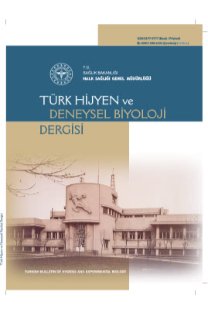Üçüncü basamak bir hastanede tespit edilen cerrahi alan enfeksiyonlarının değerlendirilmesi
Evaluation of surgical site infections detected in a tertiary care hospital
___
- 1. Anderson DJ, Podgorny K, Berríos-Torres SI, Bratzler DW, Dellinger EP, Greene L, Strategies to Prevent Surgical Site Infections in Acute Care Hospitals: 2014 Update. Infection Control and Hospital Epidemiology, 2014; 35(6):305-37
- 2. Lewis SS, Moehring RW, Chen LH, et al. It is time to change our focus: surgical site infections account for the greatest proportion of hospital-aquired infections. Infect Control Hosp Epidemiol 2013; In press
- 3. Uzunköy A. Cerrahi alan enfeksiyonlarında ameliyathanenin rolü. Harran Üniv. Tıp Fak Derg, 2004; 1:38-48.
- 4. Horan TC, Andrus M, Dudeck MA. CDC/NHSN surveillance definition of healthcare-associated infection and criteria for specific type infections in the acute care setting. AmJ Infect Control, 2008; 36: 309-32.
- 5. CLSI. Performance Standards For Antimicrobial Susceptibility Testing; Twenty-First Informational Supplement. CLSI Document M100-S20. Clinical And Laboratory Standards Institute. Wayne, PA. 2010.
- 6. Varela JE, Wilson SE, Nguyen NT. Laparoscopic surgery significantly reduces surgical-site infections compared with open surgery, Surg Endosc. 2010 Feb;24(2):270-6. doi: 10.1007/ s00464-009-0569-1. Epub 2009 Jun 17.
- 7. Watanabe M, Suzuki H, Nomura S, Maejima K, Chihara N, Komine O, et al. Risk factors for surgical site infection in emergency colorectal surgery: a retrospective analysis. Surg Infect (Larchmt). 2014 Jun;15(3):256-61. doi: 10.1089/ sur.2012. 154. Epub 2014 May8.
- 8. Willke A, Baksan S, Palabıyıkoğlu İ, Erdem B, Kökse T. Ankara Üniversitesi Tıp fakültesi İbn-i Sina Hastanesi’nde 1992–1998 yıllarında gözlenen hastane infeksiyonları. Hastane İnfeksiyonları Derg, 2001;5:31–7.
- 9. Yıldız O, Alp E, Duygulu F, Aygen B, Sümerkan B, Doğanay M. Erciyes Üniversitesi Hastanesinde Ortopedik Cerrahi Girişimlerden Sonra Gelişen Cerrahi Alan Enfeksiyonlarının prevalansı. Erciyes Tıp Derg, 2006;28(2):57–64.
- 10. Demirtürk N, Demirdal T. Kocatepe Üniversitesi Tıp Fakültesinde tespit edilen cerrahi alan infeksiyonlarının değerlendirilmesi: İki yıllık veriler. SDÜ Tıp Fak Derg 2011;18(1):12–75.
- 11. Korol E,Johnston K, Waser N, Sifakis F, Jafri HS, Lo M, et al. A systematic review of risk factors associated with surgical site ınfections among surgical patients. 2013 Dec 18;8(12):e83743. doi: 10.1371/journal.pone.0083743. eCollection 2013.
- 12. Saçar S, Toprak SK, Asan A, Cevahir N, Serin S, Tırgut H. Pamukkale Üniversitesi Hastane’sinde Hastane Enfeksiyonları Sürveyansı: Üç Yıllık Analiz. İnfeksiyon Derg, 2008;22(1):15-21.
- 13. Şardan YÇ, Aşçıoğlu S, Büke Ç, Şaban Esen, Dilara İnan, Serhat Ünal. Yoğun Bakım Ünitelerinde Hastane Enfeksiyonlarının prevalansı: Çok merkezli bir nokta prevalans çalışması Hastane İnfeksiyonları Derg, 2006;10:33.
- 14. Turner PJ. MYSTIC Europa 2007:activity of meropenem and other broad-spectrum agent nosocomial isolates. Diagn Microbiol Infect Dis. 2009 Feb;63(2):217-22.doi:10.1016/ j.diagmicrobio.2008.11.004. Epub 2008 Dec 12.
- 15. Kaye KS, Schmit K, Pieper C, Sloane R, Caughlan KF, Sexton DJ, et al. The effect of increasing age on the risk of surgical site infection. J Infect Dis 2005 Apr 1;191(7):1056-62. Epub 2005 Feb 24..
- 16. Leblebicioglu H, Erben N, Rosenthal VD, Sener A, Uzun C, Senol G, et al. Surgical site infection rates in 16 cities in Turkey: findings of the International Nosocomial Infection ControlConsortium (INICC). Am J Infect Control. 2015 Jan;43(1):48-52. doi: 10.1016/j.ajic.2014.09.017.
- 17. Doğan SŞ, Paköz NE, Aral M. Laboratuvarımıza Gönderilen Yara Yeri Örneklerinden İzole Edilen Mikroorganizmalar ve Antibiyotiklere Direnç Durumları. Türk Mikrobiyol Cem Derg.,2010;40(4):243–9.
- 18. Bayram Y, Parlak M, Aypak C, Bayram İ. Three-year Review of Bacteriological Profile and Antibiogram of Burn Wound Isolates in Van, Turkey. Int J Med Sci 2013;10(1):19–23.
- 19. http://ecdc.europa.eu/en/healthtopics/ antimicrobial_resistance/pages/index.aspx (Antimicrobial resistance surveillance in Europe 2014, The European Centre for Disease Prevention and Control (ECDC), 30 Aralık 2015).
- 20. http://uhes.saglik.gov.tr/Login/Login. aspx?ReturnUrl=%2f (29 Aralık 2015).
- 21. Korkmaz P, Çağlan FÇ, Aykın N, Alpay Y, Güldüren HM, Bilgili H, et al. Hastane Enfeksiyonu Etkeni Acinetobacter Baumannii Suşlarında antibiyotik Direnci. J Clin Anal Med, Doi:10.4328/JCAM.3156.
- 22. Kirişçi Ö, Özkaya E, Çalışkan A, Özden S, Alkış Koçtürk S. Klinik örneklerden izole edilen Acinetobacter türlerinde direnç profilinin incelenmesi.ANKEM Derg, 2013;27(3):140-6.
- 23. Gözütok F, Mutlu Sarıgüzel F, Çelik İ, Berk E, Aydın B, Güzel D. Hastane infeksiyonu etkeni Acinetobacter baumannii suşlarının antimikrobiyal direnç oranlarının araştırılması. ANKEM Derg, 2013;27(1):7-12.
- ISSN: 0377-9777
- Yayın Aralığı: 4
- Başlangıç: 1938
- Yayıncı: Türkiye Halk Sağlığı Kurumu
Üçüncü basamak bir hastanede tespit edilen cerrahi alan enfeksiyonlarının değerlendirilmesi
Dilek KANYILMAZ, Hürrem BODUR, Aliye BAŞTUĞ, Esragül AKINCI, Pınar ÖNGÜRÜ, Adalet AYPAK, Halide ASLANER, Ayşe BUT, Meltem Arzu YETKIN
Bir hastane yemekhanesinde yaşanan gıda zehirlenmesinin incelenmesi
Berrin KÜÇÜKTÜRKMEN, Asuman BOZKIR
Kemal YELEKÇI, Begüm EVRANOS AKSÖZ, Gülberk UÇAR
Türkiyenin Doğu Karadeniz Bölgesi’nde istilacı Aedes türlerinin izlenmesi ve kontrolü
Hilal BEDIR, Berna DEMIRCI, Zehra Özlem KURTCEBE, Muhammet Mustafa AKINER, Rıdvan DEMIRTAŞ, Seher TOPLUOĞLU, Ünal ALTUĞ, Hasan IRMAK, Murat ÖZTÜRK, Ahmet Ferhat DOĞAN, Akgün GÖKDEMİR
Ecem KAYA SEZGİNER, Nuri ÖZMEN, Filiz BAKAR ATEŞ, Emin Emre KURT
Psychoda albipennis’e bağlı tekrarlayan üriner miyazis
